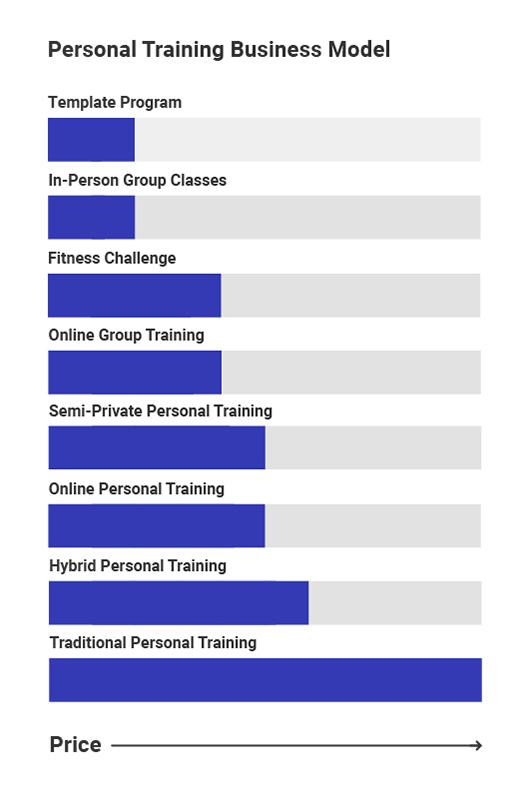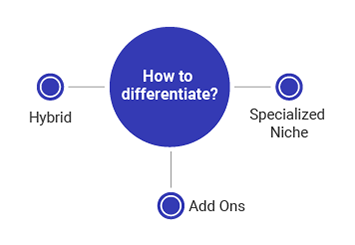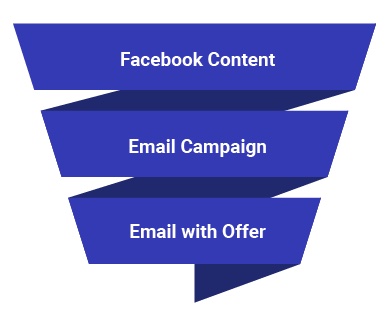
So you’ve gotten your personal training certification and you’re ready to help clients live their best lives! There are so many ways to be successful in the fitness industry and starting your own personal training business can be a great way to make a profit doing something you’re passionate about.
Grow Your Fitness Brand with Trainerfu – Start Now!
Build your brand and attract more clients with marketing tools that work. Discover how Trainerfu can help you promote your business effortlessly.
Try it freeBut as you can probably imagine, starting a business from scratch is never easy, and there are plenty of hurdles to jump through to get your concept off the ground. Fortunately, the benefits of having your own business typically negate the many challenges and with patience and persistence, you can start a successful personal training business that’s rewarding and profitable.
And we’re going to make it all easier by laying out some of the most important steps!
Inside this blog:
- Chapter 1: Small Business Basics
- Chapter 2: Personal Trainer Business Models
- Chapter 3: How To Nail Down Your Niche To Get The Best ROI On Marketing Efforts
- Chapter 4: How To Differentiate And Outcompete
- Chapter 5: Building Success Stories
- Chapter 6: Marketing Your Business With Sales Funnels
Let’s get to it.
Small Business Basics
Before doing anything else, you need to lay the groundwork for your business.
To make your business legal (even if it’s just a freelance personal training venture), you will need to register as a Limited Liability Company (LLC) or other official entity beyond sole proprietor. This typically can be done online through your local government. The fees for registering your business will likely range from a one-time payment of $50-$100 with some states requiring much smaller renewal fees each year. Registering for an LLC can give your small business more credibility, provide liability protection, and offer more flexibility when tax time comes.
In addition, you will want to obtain a business license which will legally give you permission to run your business from home and is necessary for some most business bank accounts. Check your local laws for other business-related requirements.
Locking down the right insurance is another big item to check off your small business to-do list. This is important for all businesses, but especially so for personal trainers since there is a risk of injury with fitness.
Insurance is all about protecting yourself from worst case scenarios, and having the right insurance in place can cover you if a client happens to get hurt during your training. Plus, some states require personal trainers to have insurance to maintain their business licenses, so you’ll want to get this in place right away.
Personal Trainer Business Models
You may already have an idea in mind of how you’d like to train your clients. Do you want to work at a gym? How about from your home? If you haven’t thought about these things yet, now’s the time to figure out the personal trainer business model you’re going with.
Let’s break down some of the most popular options for independent personal trainers.

Mobile
With mobile personal training, you bring yourself and your services to your clients. This typically involves driving to their homes or meeting them in designated places where you can work with them one-on-one.
This can be a great way to enjoy a flexible schedule and spend your time in a nontraditional work setting. It has a relatively low start up cost (assuming you already have a car!). It’s also an easy way to stand out and differentiate from other trainers. Seniors, people that work from home and, and busy clients will all appreciate the ability to get training in from the comfort of their homes.
Of course, there are some downsides to this model. Expect to spend many hours in your car each week and to run into some scheduling difficulties. Your training will also be limited by the equipment you can fit into your car and many people don’t have enough space in their homes for this type of training. Let’s talk about a model that isn’t as limited by these issues.
Personal Training Studio
Perhaps your dream is having your own fully built out space where clients can come to you for training. Having your own studio is another great business model if you want to become a successful personal trainer.
For this, you’ll need to buy or rent a sizable space that you can fill with all the equipment you need. This can be a great way to build a strong fitness brand and grow your business quicker. A great space in a good location can even serve as its own advertisement and help more local clients find you. It will also allow you to grow and hire help in the future without having to change your model.
The main con to consider with this model is cost. Renting or buying your own space can be expensive, especially at the start. You’ll also have monthly expenses to contend with and ongoing upkeep and maintenance.
At-Home Personal Training
You can get around the high cost of having your own studio space by training clients in your own home! In the at-home personal training model, clients come to you.
For this model, the investment cost is lower, but you’ll still want to stock your training space with equipment like: dumbbells, kettlebells, an adjustable bench, resistance bands, medicine balls, a rower, stationary bikes, workout mats, etc.
This can be a great model for independent personal trainers to build a strong client base. As time goes on though, you may find it challenging to expand within the confines of your home.
Rent Gym Space
If paying for or building out your own space sounds a little overwhelming, there’s still another business model that might make more sense for you. You can choose to rent gym or studio space from another fitness business owner.
In this model, you get to use the space to train clients in exchange for either a fixed rate each month or a percentage of your earnings. This can be great because working out of a gym can help you appear more professional and provide you with all the equipment and space you need. Plus, there’s no initial investment cost up front.
Your main challenge with this model will be finding a gym that’s open to it or one that’s not already committed to other personal trainers.
100% Online
Lastly, if you’re willing to step outside the box of traditional personal training, 100% online personal training is a great business model. With online training, you deliver your training to clients remotely through workout videos, check-in messages, and supplemental materials like nutrition guides.
For this model, you don’t have to worry about having your own space. Plus, it is typically a more affordable and flexible option for clients, helping you attract and serve a broader market.
Its low investment cost can be really enticing! The only downside is that it can take some serious marketing prowess to make this model work considering that many people aren’t even aware that online personal training exists.
When trying to decide on a business model, let your ideal clients influence your decision. Let’s talk more about what a niche is, how to find yours, and the impact it makes on other aspects of your business.
How to Nail Down Your Niche to Get The Best ROI on Marketing Efforts
All marketing efforts take time and money. The best way to make sure that you are making the most of these precious resources is to only market to people that will give you the highest ROI on your marketing efforts, AKA your niche. Nail down your personal training niche and tailor all of your marketing content to that target audience.
If you aren’t clear on your niche for your personal training business, here are some tips to help:
1. Think about who your happiest clients are ; these are the people that understand the value of your service, have worked with you the longest, and are eager to share their positive experiences. Are they busy women looking to lose weight? Or are they seniors looking to gain more strength and mobility? Which client have you been able to bring the best results?
If you’re just starting out, think about who you want to work with, and which segment of the population you think you are most qualified to help.
2. Make sure your niche is the right size . The important next step is making sure that your niche is the right size. For example, targeting “people that want to get in shape” might be a bit too broad. Whereas, “people with rotator cuff injuries” might be a little too narrow.
You’ve got to find the sweet spot, where the market is large enough to meet your revenue goals, but not so big that you aren’t able to tailor your marketing efforts accordingly.
3. Pick a niche that matches your passion and your skills. Lastly, an incredibly important part of niching down is making sure you are qualified to work within your niche and that you actually enjoy doing so. This part is especially vital because it determines how you will excel in your business and build your reputation. The passion for what you do will come in handy when things get tough, and your expertise/experience in a certain area makes you more qualified than others to serve your particular niche.
Important point – This step could easily be placed before the prior step of figuring out your business model as each can influence the other. For example, if you decide you want to train seniors with mobility issues then mobile PT might be the perfect business model for you.
How to Differentiate and Outcompete
Your business model and niche are important steps that will help the right clients find you. However, it’s time to dig even deeper if you want to truly stand out from the competition.
Find Your Unique Value Proposition
Once you know your niche, you can determine your unique value proposition. Your unique value proposition is “a clear statement that describes the benefit of your offer, how you solve your customer’s needs and what distinguishes you from the competition.”
When trying to determine your UVP, think about your competition – fitness businesses that are serving the same niche as you. Your competition might not be who you think it is. For example, your biggest competitor may not be a personal trainer in another town. Instead, it might be a local fitness studio that your ideal client might go to instead.
Next, think about how your way of doing things differs from your competition. What’s your unique experience, background, and method? How does it shape the impact you make? Think about the unique benefits of personal training you can provide that your clients truly care about.
If your niche is busy moms that want to get in shape, how exactly do you help them do that? What makes you stand out from other trainers helping the same group? Be sure to focus on what you do well, not what other trainers do poorly.
Get clear on your UVP. Turn it into a mission statement. This is important because it will appear prominently in all of your marketing materials and help you stand out in the oversaturated fitness market.
3 Unique Ways to Differentiate Your Personal Training Business
Getting clear on your UVP can help you differentiate yourself from the competition. But if you need a little more help trying to figure out the unique benefit of your offer or how you do things differently from your competitors, consider some of the following options.

1. Attract a larger market with hybrid and online programs.
In traditional personal training, clients meet trainers in-person 2-3 times per week. For many folks this is too expensive and hard to commit to. So even though they may want a more personalized experience, they stick with the standard gym membership and never consider personal training as much of an option.
However, with online personal training or hybrid training (both online and in-person), clients get to enjoy more flexibility, affordability, and customizability than the traditional personal training model. This helps you open up your training to a larger unserved market that is excited about a new way of doing things.
Offering online training isn’t something that every trainer does. So when a particular client is looking to squeeze personal training into a busy schedule or is hesitant to spend the full cost of in-person training, they will come to you instead! It’s a win, win for everyone.
2. Offer more than just workouts with online personal trainer software.
Another way to stand out from the crowd is by going above and beyond what’s expected of personal trainers. Not only should you deliver great workouts, but you should also include extra components that up the value of your training.
With TrainerFu’s personal training software, you can easily offer extras like:
- Nutrition coaching
- Habit coaching
- Content
- Community
- 24/7 support
Adding these things will help your clients get better results. This is great for retention and will also increase the amount of referrals you have rolling in.
3. Create a signature program for a specialized niche.
Building out a great program that’s uniquely yours will help you get recognized as a standout and special business.
Drill down on your niche and the kinds of problems they have. Get even more specific and create a very personalized workout program that you can sell to that segment. For example, you could create a program geared toward working moms that focuses on big results with little time or a program for postnatal strength building.
Your program can be automated and templated so that you can use it for the same type of client again and again. You will become known for delivering this certain type of result and the right clients will seek you out.
Building Success Stories
Once you’re ready to start marketing your business, it’s important to keep in mind the power of social proof. Other people’s positive opinions about your business are one of the strongest marketing tools you can have. In fact, 82% of Americans say they seek recommendations from friends and family before making a purchase and 70% of people will trust a recommendation from someone they don’t even know.
To get more clients, you need to gather and share success stories from past clients. Did you work at the gym before? Is there anyone that would be willing to share their experience working with you?
If you haven’t worked with any clients yet, that’s ok. Offer a discounted rate to get your first customers or ask friends and family to join your program. Make sure to document results and record their testimonials to start building your story backlog.
Marketing Your Business With Sales Funnels
A sales funnel is a path a prospect takes to become your paying customer. When most people first hear about you or stumble across your website, they are not quite ready to buy from you. These are often called “cold” leads. These leads still have a lot of unanswered questions and will take some convincing before they pull out their wallet.
Your sales funnel is how you answer these questions, form a relationship, and help these leads get to know you. This warms them up to the idea of spending the money to work with you. By the end of a good sales funnel, these leads are more familiar with you and your brand, and are more primed to buy from you.
There are three main phases of a sales funnel:
- Attract- In this stage, you catch the attention of ideal clients. You can do this in many ways like a great blog that answers a question they typed into Google or a free YouTube workout class.
- Nurture - Once clients are aware of your services and the problem you solve, nurture the relationship by continuing to tell them more about you and why they need your solution.
- Convert - The final stage involves closing the deal with your unique offer.
Let’s see some sales funnels in action.
Funnel Idea 1
This first funnel example is an easy one that doesn’t require too much work. It involves attracting your ideal clients by attending meet-ups, hosting an event, or receiving referrals. Once the prospect knows about you, you can nurture the relationship with a sales meeting or free training session. This gives them a taste of working with you and helps them trust that you can bring them results. Finally, convert the client by offering a discounted rate if they commit to more training.
Referral → Sales Meeting → Discounted Offer

Funnel Idea 2
Let’s talk about another way a prospect might become a paying client. Use great Instagram content to attract ideal clients and build awareness. Once a prospect has followed you for a while, they might be ready for more information about your services. Invite them to a sales meeting or include the link to schedule a consultation in your Instagram bio. During your call, present them your offer to close the deal!
Great Instagram content → Free Consultation → Unique Offer

Funnel Idea 3
Some prospects might need a little more nurturing, though social media is still a great place to attract them and help them get to know you. Let’s say someone really enjoys the information you share on Facebook. In one of your posts, you invite followers to join your email list, and that ideal client does. Nurture the relationship with a great email sequence and finally, present your offer in email content.
Facebook Content → Email Campaign → Email with Offer (that makes it easy to sign up)

Are You Ready to Start Your Personal Training Business?
Everyone’s path to success looks different, but following the steps above can help you get your business off the ground.
There are plenty of logistics to figure out as well as certain marketing strategies that will help make your business a success. As your business grows, it can be helpful to outsource certain areas of running your business to other professionals. In the meantime, we have some great resources that you can use to make starting and running your business easier.
Frequently Asked Questions
1. What are the initial steps to start a personal training business?
Begin by obtaining relevant certifications to ensure you have the necessary knowledge and credibility. Develop a comprehensive business plan outlining your services, target market, and financial projections. Register your business legally, choose a suitable business model (e.g., mobile training, personal studio, online coaching), and secure appropriate insurance coverage.
2. How important is certification for personal trainers?
Certification is crucial as it validates your expertise and enhances client trust. Accredited certifications from recognized organizations ensure you meet industry standards and can legally operate in many regions.
3. What business models can personal trainers adopt?
Personal trainers can choose from various models, including:
- Mobile Training: Traveling to clients’ locations.
- Personal Training Studio: Operating from a dedicated space.
- Online Training: Offering virtual sessions and programs.
- Hybrid Model: Combining in-person and online services.
4. What legal considerations should I be aware of?
Register your business entity (e.g., LLC) to protect personal assets. Obtain necessary licenses and permits as required by local regulations. Ensure compliance with health and safety standards.
5. How can I set competitive pricing for my services?
Research local market rates for personal training services. Consider your experience, specialization, and operating costs. Offering various packages or group sessions can provide flexible pricing options for clients.
6. How can I ensure client retention and satisfaction?
Provide personalized training programs tailored to individual goals. Maintain regular communication and track client progress. Continuously update your skills and knowledge to offer the best service possible.
Check them out here: